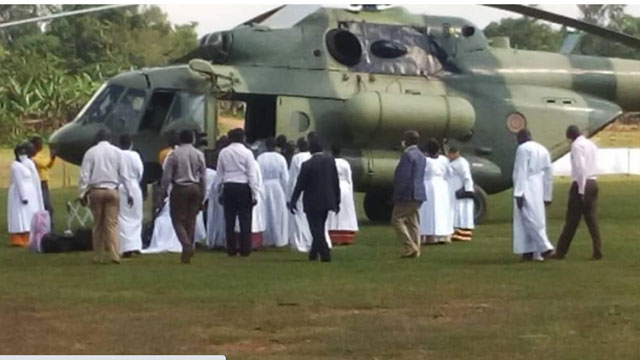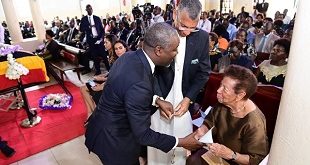
Kagadi, Uganda | THE INDEPENDENT | Only 200 people have been allowed to attend the burial of Desteo Owobusobozi Bisaka, the head of Faith of Unity. Bisaka is being laid to rest this afternoon at the Faith of Unity Healing City Kapyeemi in Muhorro town council in Kagadi district.
The late Bisaka died in the Aga khan hospital in Kenya’s capital Nairobi on January 13th, 2021 but his family remained tight-lipped on the matter an only announced the death on January 23rd, 2021.
His body was airlifted by a military chopper to his ancestral home on Sunday last week ahead of the burial today. Lillian Ruteraho, the Kagadi Resident District Commissioner-RDC told Uganda Radio Network that only 200 People have been cleared to attend Bisaka’s burial.
According to Ruteraho, they decided to restrict the number of mourners to comply with the Standard Operating Procedures-SOPs set by the Health Ministry to contain the spread of COVID-19. She says only those with invitations will be allowed to attend the funeral.
*****
Who is Bisaka?
He was born on June 11th, 1930 in Kitoma-Kiboizi village in Buyanja county, Kibaale district in Western Uganda. His parents were Petero Byombi and Agnes Kabaoora. Both of them were staunch members of Bujuni Catholic parish in Kagadi district. Bisaka spent little time with his parents as he lived and grew up with his grandparents from the age of eight years.
His father was a Catholic catechist as was his grandfather, Alifonsio Wenkere, who was a pioneer convert at Bujuni Catholic parish. His grandmother, Martha Nyakaka was also a Catholic convert and a captive in the palace of Mengo where she witnessed the martyrdom of Charles Lwanga and 21 other Ugandan martyrs in the 19th century.
Bisaka grew up and attended Mugalike School, wherein 1944; he applied to enrol in the Catholic seminary where local priests were being trained. Failing to be admitted to the Catholic priesthood training program, he went to Nsamizi Teachers College, Mityana, where he trained to become a teacher.
On graduation, he was employed at Muhorro Catholic Primary School, where he taught for 35 years. Like his father and grandfather who were catechists in the Catholic Church, Bisaka was a prominent member of the local church and leader of the parish laity.
He was parish council secretary, a position that gave him access to a high-level decision-making platform in the management of the ritual life of the church. Because the ecclesiastic leadership noticed his devotion, he was also appointed as the advisor to the group known as the Legion of Mary Mother of Grace Confraternity.
Here he had to guide the members of the laity in their devotion to Mary, the mother of Jesus Christ, as well as teach the group elements of Catholic doctrines and liaise between the group’s leadership and parish and diocesan leadership of the Catholic Church.
Significant in Bisaka’s future ambition and mission was his musical gifts and skills, which led to his appointment into the Catholic Diocese of Hoima’s liturgical committee. As the choirmaster of the parish in Muhorro, he was a composer of liturgical hymns for the church beyond the parish level, a practice that soon brought recognition and popularity to him, but also a grudge.
The Catholic Diocese of Hoima made use of his hymns in its rituals without adequately remunerating him. While Bisaka’s sacred hymn composition started in 1966, it was not until 1975 that a radical change occurred that would ultimately precipitate the formation of the Fountain of Unity.
In 1975, Bisaka composed a hymn; Nkaikiriza Ruhanga Murungi (My God is good). As the lyrics of this song indicate, it is theologically meaningful and cheerful–hence its popularity within and outside the Catholic Church in East Africa. It is claimed that from the time this song was first used in Catholic liturgy, Bisaka started experiencing unusual vibrations in his hand.
There started coming in his arms a special kind of power whenever he would sing it the song in church, a phenomenon that increased with time and became noticed by a large circle of church members including some of the clerics, who attributed it to the ‘composing of the hymn, Nkaikiriza.
After five years of trying to understand the spiritual and bodily change that he was experiencing, Bisaka claimed to have heard a voice of God commanding him. “You shall heal people by touching them”. However, URN could not independently verify this claim.
For three months Bisaka was hesitant, even afraid and unsure of what to do, but the voice was repeatedly insistent as well. The date for the establishment of the Faith of Unity is 22 February 1980 and it is believed that on this day Bisaka reluctantly touched a young woman suffering from severe and debilitating feverish conditions associated with malaria. She was instantly healed and restored to health.
His sacred duty is to fight Satan and unify humankind through preaching unity, using healing to draw people together and capture their attention resulting in people bringing many sick people to him to be healed by physically touching them.
For decades since the formation of Faith of Unity, Bisaka has gathered a large following and he is explicitly believed by followers (Abaikiriza) to be God. The core doctrine of the Faith of Unity is about the divinity of Bisaka.
Soon after his healing activities started, Bisaka had another spiritual experience, which is described by some elders of the movement as a trance-like event where ‘he went to see the Lord of hosts, an experience that lasted for three days.
From this experience emerged a tripartite conception of the deity of which Bisaka was elevated into godhood with a full title of Omukama Ruhanga Owobusobozi Bisaka, loosely translated as ‘the Lord God of the power of God. The remaining two personalities of the deity are the Lord God of hosts and the Lord God of holiness.
His sacred duty is to fight Satan and unify humankind through preaching unity, using healing to draw people together and capture their attention. The Faith of Unity congregation prays every second, 12th and 22nd day of the month. For the rest of the days, each follower develops a list of good things they hope for daily.
The group does not believe in the Bible, calling it divisive but use ‘the book of the Faith of Unity’ authored by Owobusobozi and spells out cleaning courtyards, grazing animals, washing, hunting, donating, smiling at friends and praying to God as deeds that can give one eternal life.
****
URN
 The Independent Uganda: You get the Truth we Pay the Price
The Independent Uganda: You get the Truth we Pay the Price



The followers followed him because he was seeing what they could not, thus hopping to see as he was seeing at a later time. Rip. Bisaka.
IS REAL GOD.